

 |
Search the Site with

|
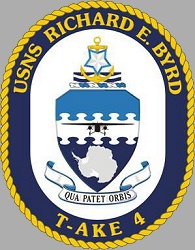 | 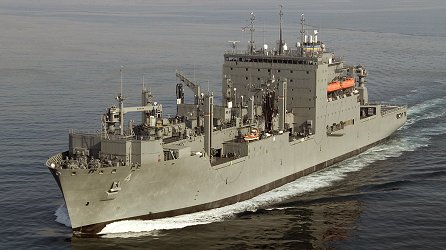 |
USNS RICHARD E. BYRD is the fourth LEWIS AND CLARK - class Dry Cargo / Ammunition Ship and the second ship in the Navy to bear the name.
| General Characteristics: | Awarded: July 18, 2003 |
| Keel laid: July 28, 2006 | |
| Launched: May 15, 2007 | |
| Delivered: November 14, 2007 | |
| Builder: National Steel and Shipbuilding Company, San Diego, Calif. | |
| Propulsion system: Integrated propulsion and ship service electrical system, with generation at 6.6KV by FM/MAN B&W diesel generators | |
| Propellers: one | |
| Length: 689 feet (210 meters) | |
| Beam: 106 feet (32.31 meters) | |
| Draft: 29.5 feet (9 meters) | |
| Displacement: approx. 41,000 tons full load | |
| Speed: 20 knots | |
| Dry Cargo Capacity: 1,388,000 cubic feet | |
| Fuel Cargo Capacity: 26,000 barrels | |
| Aircraft: two helicopters | |
| Armament: none | |
| Crew: approx. 125 civilians and up to 49 US Navy | |
| Homeport: Pacific |
Crew List:
This section contains the names of sailors who served aboard USNS RICHARD E. BYRD. It is no official listing but contains the names of sailors who submitted their information.
About the Ship's Coat of Arms:
 The Shield:
The Shield:
Dark Blue and Gold are the colors traditionally associated with the Navy. Rear Admiral Byrdís area of exploration, illustrated by the following images: the Lighter Blue denotes the geographic position of the North Pole, in the middle of the Arctic Ocean; the Dark Blue with the stylized landmass alludes to Antarctica located over the South Pole. The nebuly, the heraldic symbol for the sky, indicates RADM Byrdís military career as an aviator. The silhouette of the trimotor plane symbolizes the aircraft piloted by the RADM over both regions, becoming the first person to fly over the South Pole and to attempt to fly to the North Pole. His accomplishments, further conveyed in the shipís motto ĎQUA PATET ORBISí, highlights his exploration of both poles or Ďas far as the world extendsí.
The Crest:
The billet and the wavys suggest the USNS RICHARD E. BYRDís transport and delivery capabilities. The anchor symbolizes the T-AKE 4 strength at sea and steadfastness. The inverted star commemorates the RADMís award of the Medal of Honor for his travel to the North Pole.
About the Ship's Name:
Richard Evelyn Byrd, son of Richard E. and Eleanor Bolling Byrd and younger brother of Senator Harry Flood Byrd, Sr., was born in Winchester, Va., 25 October 1888. After graduating from the Naval Academy 7 June 1912. Byrd was assigned to battleship SOUTH CAROLINA (BB 26), and subsequently served in KENTUCKY (BB 6), WYOMING (BB 32), MISSOURI (BB 11), WASHINGTON (ACR 11), and DOLPHIN (PG 24). He was retired 15 March 1916 because of a leg injury.
On 24 May 1916 he was recalled to active duty, limited service, and acted as Instructor-Inspector of Naval Militia, Providence, East Providence, Bristol, and Newport, R.I. After the United States entered World War I, he organized a commission on training camps.
Following flight training at Pensacola, Fla., he was designated Naval Aviator No. 608 on 17 April 1918 and served during the remainder of World War I as Commanding Officer, U.S. Naval Air Stations in Canada. In planning and executing antisubmarine patrols, Byrd pioneered in night and all-weather flying, designed improved navigation instruments, and devised a plan for a transatlantic flight, which resulted in the NC-4 flight, the first crossing of the Atlantic by air. After studying in England at the Royal Air Force School of Aerial Navigation, Byrd helped to establish naval reserve air stations throughout the United States.
In 1924 he was ordered to Washington for a proposed flight of the lighter-than-air craft SHENANDOAH (ZR 1) over the North Pole, but when the craft was damaged in a storm, the expedition was canceled.
Byrd then turned his thoughts to flight over the North Pole by heavier-than-air craft. He obtained funds from private sources to pay for the expedition and borrowed equipment such as planes, tractors, and ships from government agencies.
In the fall of 1925 Byrd's first story appeared in the National Geographic Magazine, beginning a valuable association with the National Geographic Society which continued over the next three decades.
Byrd and Floyd Bennett took off from King's Bay, Spitzbergen, 750 miles from the Pole, 9 May 1926. After 7 hours of flight they were over the North Pole. Byrd, the first man to fly over the Pole, was second only to Peary to reach that point.
In 1926 Byrd acquired an improved three engine Fokker and named it AMERICA, and prepared for a nonstop transatlantic flight to establish the feasibility of regular passenger service across the Atlantic. However, while bad luck delayed Byrd, Charles Lindbergh took off from New York on 20 May 1927 and landed at Paris 33 hours later. The AMERICA departed New York 29 June 1927, found Paris fogged in, and so landed in the ocean just off the French coast. Byrd and his three crewmen were rescued, taken to Paris, and then returned to an enthusiastic welcome in New York.
Byrd's first Antarctic expedition, consisting of CITY OF NEW YORK and ELEANOR BOLLING, departed the United States 28 August 1928; steamed via the Panama Canal and New Zealand; and, on 1 January 1929, established a base on the Bay of Whales, Antarctica, named Little America. Byrd and three companions took off from Little America 28 November 1929 in the ski-equipped trimotored monoplane, FLOYD BENNETT, and headed for the South Pole where they dropped an American flag. When Byrd returned to the United States, he was promoted to rear admiral.
In 1933-35 he led a second expedition to Antarctica. Living at an advanced base to record weather data during the long winter night, Byrd nearly died from carbon monoxide. Although rescued in time, he suffered from the ill effects of the poisoning for the rest of his life.
Byrd's third expedition consisted of the Navy commissioned and manned BEAR (AG 29) and Department of the Interior's NORTH STAR. Two wintering over bases were established and scientific investigation was intensified.
During World War II, Admiral Byrd studied and reported on the suitability for airfields.
After the war ended, Byrd resumed polar exploration. During Operation "Highjump" he led an expedition of 4,700 men and modern support equipment in 13 ships to the Antarctic. They explored much of the little known continent and added greatly to man's knowledge of the region.
In 1954 the Secretary of Defense agreed to furnish logistic support for American scientists in the Antarctic for the International Geophysical Year which would begin on 1 July 1957. President Eisenhower appointed Byrd, Officer-in-Charge of U.S. Antarctic programs.
Admiral Byrd remained active in exploration of Antarctica until he died in his home at Boston on 11 March 1957.
USNS RICHARD E. BYRD Image Gallery:
The photos below were taken by me at Naval Base San Diego, Calif., on March 10, 2008.
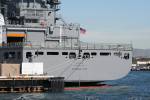 | 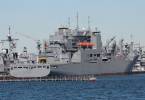 | 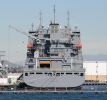 |
 Back to Dry Cargo / Ammunition Ships Page.
Back to Dry Cargo / Ammunition Ships Page.  Back to ships list.
Back to ships list.  Back to selection page.
Back to selection page.  Back to 1st page.
Back to 1st page.